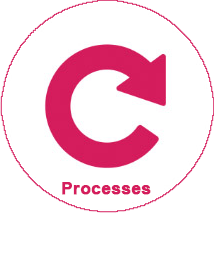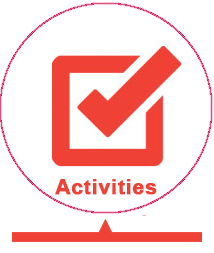The AIT-PMF includes text that describes the key roles and responsibilities that are involved during each process phase. This content is broken down below in a table format for ease of reference.
 Concept
Concept-
Identify the Specific Business Problem or Opportunity - The process of developing a project concept starts by clearly defining a business problem or opportunity. This helps determine whether the problem or opportunity can be solved by allocating resources to create a project solution, and also supports the process of getting funds for the project.
Establish a Clear Business Case - A clear business case will help build support and commitment for the project from the sponsoring organization’s leaders, as well as from external control agencies and the Legislature. Project leadership should be able to address fundamental questions about the project. If a clear business case can’t be developed, it’s important to identify this early before more resources are expended.
Assess the Organizational Impact - IT projects cause organizational change. Organizational change management must be considered and effectively addressed to maximize the likelihood of project success. Questions to be considered include who will be affected, what will the impacts be, when should the changes be planned, and is the organization ready for the changes?
Complete the Concept Development and Readiness Assessment - An environmental readiness assessment gives the organization an opportunity to adjust its project strategies, plans, and timing. Assessment topics that should be considered include organizational maturity and preparedness, organizational culture, capacity for launching a new project, project governance, the organization’s track record with projects, and lessons learned from previous endeavors.
Conduct a High-Level Risk Assessment - Conducting a review of the responses to the Concept Development and Readiness Assessment criteria, as well as the recommended actions and next steps noted, may help provide an initial gauge of the level of risk associated with the project.
Begin drafting the Stage 1 Business Analysis Documentation (PAL) - The State’s project approval process begins during the Concept Process Phase, with a draft Stage 1 Business Analysis (S1BA) as part of the Project Approval Lifecycle (PAL). The information that is gathered from the Concept Development and Readiness Assessment can be useful in departmental and/or statewide project approval processes. Additional information on the S1BA and PAL can be found in SIMM 19.
Complete the Concept Process Phase Checklist - This checklist identifies the key activities to be accomplished during the Concept Process Phase.
 Initiating
Initiating-
The following processes are associated with this process phase. The list below contains a high-level description of these processes. See the Processes and Activities section of the Concept chapter in the CA-PMF for more detail.
Identify the Project Sponsor(s) and Stakeholders - The sponsoring organization’s leadership typically will be tasked with the assignment of a Project Sponsor and the preliminary identification of key potential Stakeholders. If applicable, consult with the organization’s Project Management Office (PMO) or IT Governance Process to determine if there already are internal processes for proposing and approving project concepts. Typically, a Project Manager has not yet been formally named at this early stage.
Conduct a Readiness Assessment - The Readiness Assessment is used to communicate the reason for taking on the project, including the business problem or opportunity to be addressed, potential benefits and outcome, strategic alignment, and return on investment. It also assesses the potential project’s impacts on the organization and its staff, and whether the organization is prepared to successfully conduct the project.
Project Approval Process - The state’s project approval process starts during the Concept Process Phase. This includes completing and submitting a draft Stage 1 Business Analysis (S1BA) as part of the Project Approval Lifecycle (PAL). The information compiled for Concept Development and Readiness Assessment can be useful in departmental and/or statewide project approval processes.
Concept Process Phase Review - A Concept Project Phase Checklist is completed after all of the phase’s activities are done. This ensures that the necessary activities have been completed and that a foundation has been established for the project.
 Planning
Planning-
The following activities are undertaken in support of the processes that are associated with this process phase. The list below contains a high-level description of these activities. See the Processes and Activities section of the Planning chapter in the CA-PMF for more detail.
Complete the Complexity Assessment - The Complexity Assessment is typically based on assessments of both the business and technical complexity of the project. These include organizational factors of the sponsoring organization; knowledge of the target user group; Project Manager and team member experience; the time constraints associated with implementation; the political visibility of the project; and the organization’s familiarity with the proposed solution. The Complexity Assessment provides a structured approach for identifying risks and can help drive planning efforts to help lessen risks. The Department of Technology (CDT) requires completion of the Complexity Assessment as part of the Project Approval Lifecycle (PAL) for review at specified stages/gates.
Update the RACI Matrix - Initially drafted during the Initiating Process Phase, the RACI Matrix can now be updated based on new information. This includes updating the RACI Matrix using the Project Management Plan and subordinate plans that will be developed based on the determined complexity of the project, and assigning the appropriate project team members.
Hold Planning Process Phase Kickoff Meeting - The Project Manager and Project Sponsor should conduct a Planning Process Phase Kickoff Meeting. The meeting should include review of the Project Charter and the project’s purpose, priority, and vision. The Project Manager should review upcoming planning activities and outline each person’s role in the planning process. The Project Manager may choose to go over the updated RACI Matrix.
Set Project Practices - Project practices are the rules, standards, and tools that will be used by the project team during the project but that have not been included in the Project Management Plan. Not all projects will need to develop specific project practices but it is something to consider at this time. Examples of project practices include document storage standards; adherence to security, confidentiality, and conflict-of-interest requirements; and energy conservation. Engage the project team in the development of practices and ensure all team members know about them.
Develop the Project Management Plan (PMP) - All projects must develop a Project Management Plan. The PMP describes the mechanics of how aspects of the project will be planned and managed throughout the project management lifecycle (PMLC). The PMP may be a single document containing separate sections for each of its components (often true for smaller projects), or it may simply reference standalone subordinate plans for specialized areas (more common for larger and more complex projects). The Project Manager may assign plan development to appropriate team members, and will determine which subordinate plans may also be needed. The PMP should draw information from the Project Charter, the RACI Matrix, the Stakeholder Register, and other project documentation that is available from the Concept and Initiating Process Phases.
Develop Subordinate Project Plans - To gain familiarity and knowledge, the Project Manager should review all subordinate plan narratives, templates, and instructions included in the Framework. Actual selection of which subordinate plans to use for a specific project will depend on the project’s size, complexity and special needs. Subordinate plans include Change Control, Communication Management, Contract Management, Cost Management, Governance Management, Human Resources (HR) and Staff Management, Implementation Management, Issue Management, Maintenance & Operations Transition, Procurement Management, Quality Management, Requirements Management, Risk Management, Schedule Management, Scope Management, and Stakeholder Management.
Develop the Work Plan - The project work plan is the next step in refining the project’s preliminary estimates for the scope, schedule, and resources that were prepared during the Initiating Process Phase. The work plan is developed with new information that has been gathered and analyzed. This activity includes a Work Breakdown Structure, which is a decomposition (breaking down) of a project into smaller components that are more manageable in terms of size, duration, or responsibility. Another tool, the project schedule, is developed to communicate what work needs to be performed, which resources of the organization will perform the work, and the time frames in which that work needs to be performed. Using the WBS and the project schedule as a starting point, the appropriate staffing levels are determined based on the type of project tasks and overall implementation schedule. The project budget is developed by aggregating estimated costs, including staffing, contracted services, facilities, hardware and software, and supplies.
Baseline Project Plans - For IT projects that are not reportable to control agencies, the Project Manager may baseline the Planning Process Phase artifacts once they are approved by the Project Sponsor. This provides references points for future progress and any changes. For reportable IT projects, final approval of the project scope, budget, and schedule may require actions by the Department of Technology, the Department of Finance, and/or the Legislature. The project can baseline these artifacts once the required external approvals are received.
Optimize Project Artifacts - As more information is identified and developed, the project may need to update and refine its planning documents, including those relating to the core areas of project scope, schedule, staffing, and cost. When changes are made to any of these artifacts, follow the processes and procedures documented in the Change Control Management Plan. This ensures changes are coordinated throughout all of the project’s work areas and planning documents, and that changes are approved by the appropriate project authority
Complete the Planning Process Phase Checklist - A checklist can assist the project team with quickly and confidently identifying areas of concern within this phase of the PMLC. In this case, completion of the checklist provides a clear milestone that the Planning Process Phase is complete.
 Executing
Executing-
The following activities are undertaken in support of the processes that are associated with this process phase. The list below contains a high-level description of these activities. See the Processes and Activities section of the Executing chapter in the CA-PMF for more detail.
Acquire the Project Team and Commit Resources - The Project Manager executes the project staffing approach approved in the HR and Staff Management Plan, confirming the availability of staff with the correct skills. The Project Managers also begins team development activities, which may include additional training for staff and team building to create a highly collaborative team environment.
Conduct Contractor On-Boarding - Timely and carefully planned on-boarding is essential if the project is using a contractor. The Project Manager should bring the contractor on board using the procedures created in the Planning Process Phase. These activities typically include site preparation, technology configuration, finalization of contracts, security and badge access, and signing of conflict of interest statements and non-disclosure agreements (NDAs).
Hold Executing Process Phase Kick-Off - Every project should have a kick-off meeting to help ensure everyone is on the same page and understands the reason for the project, its schedule, and team responsibilities. It is highly recommended that the Project Sponsor attend the kick-off meeting to convey how the project supports the organization’s strategic direction and, in turn, how the organization supports the project’s goals.
Transition the Project Manager Responsibilities - Some projects may transition to a new Project Manager at the beginning of the Executing Process Phase. This is typically in cases where special skills and experience are required. In any case, the new Project Manager must be fully briefed on the status of the project, the construction of planning documents, and open risks and issues.
Execute the Project Management Plan - The Project Manager should review the Project Management Plan and all subordinate plans in preparation for beginning Executing Process Phase activities. All plans have been baselined and are now under the project’s change control process.
Integrate Project and Contractor Plans – If applicable, the Project Manager and contractor-assigned Project Manager integrate state and vendor Project Management processes and procedures. Contract documents will determine whether the contractor will maintain a separate or integrated Project Management Plan (PMP), project schedule, Issue Log, and Risk Register. In either case, a significant level of planning and coordination is required.
Review and Update the RACI Matrix - The RACI Matrix identifies the deliverables for a project and the role of various Stakeholders. It is drafted during the Initiating Process Phase and updated during the Planning Process Phase. If additional System Development Life Cycle (SDLC) artifacts and deliverables are identified during the Execution Process Phase, the RACI Matrix should be updated based on the new information.
Confirm Scope and Requirements - Confirmation of scope and requirements ensures everyone is on the same page as to what is actually going to be accomplished during the project. Project contractors should be familiar with the scope and requirements of the project based on the Request for Proposal (RFP), Statement of Work (SOW) or other contract documents. Contractors and appropriate state staff should review the project vision and expected outcomes together in a formal walk-through.
Lead and Manage the Project Team - To lead the project team, the Project Manager influences the team’s behavior, resolves conflicts, motivates staff , supports the project vision, and fosters a productive and collaborative team environment. To manage the project team, the Project Manager analyzes project performance data, tracks team member performance, resolves issues, address staffing changes, and implements strategies to optimize the team’s overall performance.
Manage the Contractor Team - Specific processes are required to manage the approval and on-boarding of contractor staff , the review and acceptance of contract deliverables, and dispute resolution and escalation when there is disagreement between the state and contractor. Contractor staff should be integrated with the project team to the extent possible to promote collaboration and communication.
Manage Stakeholder Expectations - The Project Manager should implement strategies developed in the Stakeholder Management Plan and/or the Communications Management Plan to keep Stakeholders informed of project status and progress. Effective Stakeholder communications helps to increase their support of the project, minimizes resistance, addresses Stakeholders’ needs and requirements, and helps prevent future misunderstandings.
Carry Out Project Communications - The project executes its Communications Management Plan with the goal of ensuring effective, clear, and efficient project communications. This can be accomplished through project team meetings, presentations, status reports, emails, project portals, and other communication activities. All communications should be appropriately timed and include the appropriate information for the target audience.
Monitoring and Controlling Project Activities - Monitoring and controlling activities measure and analyze project performance at regular intervals to ensure project plans are being followed. The process oversee the tasks and metrics that ensure that the project is within scope, on time, on budget, and within quality thresholds. Key activities include Schedule Management; Cost Management; Scope Management, Requirements Management, and Change Control; Quality Management; Performance Reporting; Risk and Issue Management; Contractor Performance; Project Surveys; and Maintenance and Operations (M&O) Transition.
Complete the Executing Process Phase Checklist - The checklist identifies the key activities that should be completed during the Executing Process Phase.
 Closing
Closing-
The following activities are undertaken in support of the processes that are associated with this process phase. The list below contains a high-level description of these activities. See the Processes and Activities section of the Closing chapter in the CA-PMF for more detail.
Verify Acceptance of All Project Deliverables - The Project Manager verifies the acceptance of all project deliverables and the completion of all end product transition activities. This ensures that the customer has validated the project scope and that the project’s deliverables are complete and delivered as agreed to by all parties. Deliverables acceptance is based on the success criteria defined in the earlier process phases of the project. Acceptance is formal and must be approved by the Project Sponsor(s).
Resolve or Transfer Ownership of Open Issues - The Project Manager must verify that all issues remaining open are either resolved or that the issues’ ownership is transferred outside of the project (such as to Maintenance and Operations). Transfer of open issues must be formally documented and approved by both the Project Sponsor and the party accepting ownership.
Complete Final Project Status Report - The Project Closeout Report communicates the final status and disposition of a project. This report documents completion of the project’s closing activities and provides the final project performance measures (such as involving schedule, budget, quality, and issues). It is separate from the Post Implementation Evaluation Report (PIER).
Archive Final Project Records - All records, both electronic and hard copy, should be stored according to the project and organizational record retention rules and guidelines. Technical records should be made accessible to the maintenance and operation staff responsible for the project’s end product. Archived project documentation typically includes but is not limited to the Project Charter; project plans; deliverables; project reports and checklists; contract-related files; design specifications and other technical documents; issue, risk and change logs; lessons learned; and the Post Implementation Evaluation Report (PIER).
Conduct Lessons Learned - The main purpose of documenting lessons learned is to collect, use, and share knowledge derived from experience to promote the recurrence of desirable outcomes and prevent the recurrence of undesirable outcomes. Surveys or lessons learned meetings can be used to elicit feedback from project team members regarding their impressions and assessments of the project. Lessons learned provides a valuable forum for the project team to acknowledge what worked well, and it provides a chance to discuss ideas to improve processes and procedures.
Celebrate Success - When a project is successfully completed, genuine recognition and positive feedback should be provided to the project team and individual project members for their project-related efforts. Even if a project is suspended or canceled, celebrate what the team was able to accomplish and what it learned from the experience.
Conduct Contract Closeout - Contract closeout verifies that all work is completed correctly and as agreed upon, and that all contract records are updated and archived. The Project Manager will reference the State Contracting Manual for required activities. The Project Manager may consult the project’s Contract Manager, and/or procurement specialists from the agency or the California Department of Technology (CDT). Contract closure includes confirming the project has addressed the terms and conditions of the contract, verifying completion and acceptance of all contract deliverables, finalizing all payments, completing and archiving contract files, and completing Contractor Evaluations (Form STD. 4) for professional services.
Complete Project Financials - As specified in the project’s Cost Management Plan, the Project Manager works with project staff and the sponsoring organization’s accounting or budget analysts to ensure the capturing and recording of all project costs and the disencumbering of any unused budget allocations.
Release Staff - Most project staff team members and contractors generally are released at the end of the Executing Process Phase or during the early stages of the Closing Process Phase. The project follows the processes and timing outlined in its HR and Staff Management Plan and applicable contract documents.
Release Facilities and Resources – Many closing activities relate to the release of facilities and resources that have been used by the project. These activities include notifying the appropriate business services office of space vacancy/availability, closing out any lease agreements, and returning computers and related equipment to the IT office. Other activities include terminating network and computer access for staff and contractors as they are released, and collecting building and security access badges.
Complete Post Implementation Evaluation Report (PIER) - The PIER is the last post-project review and provides a record of the project’s history. The PIER should be submitted to the Department of Technology (CDT) within the Department’s required time frame. Its sections include project background and summary of results, attainment of objectives, lessons learned, corrective actions, project management schedule, and economic summary. Section 50 of the Statewide Information Management Manual (SIMM) contains “Instructions for Completing the Post Implementation Evaluation Report (PIER).” These instructions describe in detail when a PIER is required, its contents, and procedures for submission and approval.
Complete the Closing Process Phase Checklist - The Closing Process Phase Checklist identifies the key activities and dates that are completed during the Closing Process Phase of a project. Once all of the activities within the Closing Process Phase are complete, the checklist should be completed to verify completion of closing activities and that the project is ready for closure.
 Post Launch Support
Post Launch Support-






